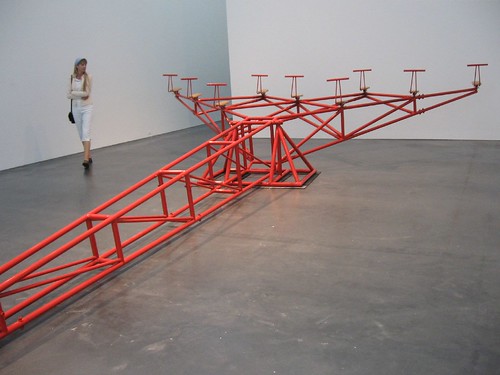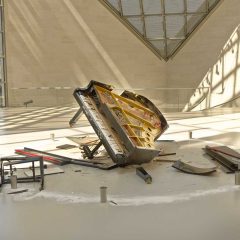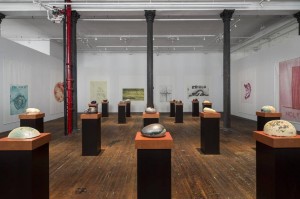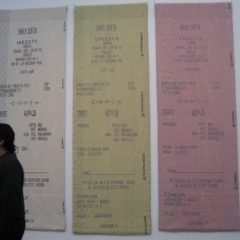This is the second of three posts on Chicago. The previous one is here.
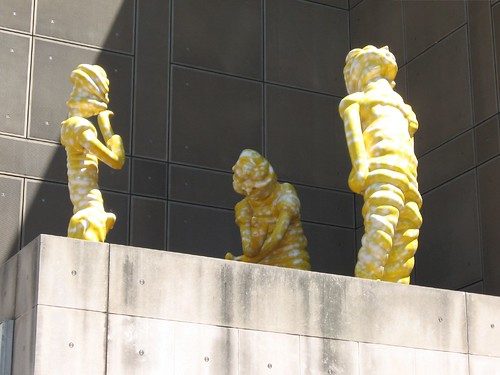
We were on our way to a view from Chicago’s Hancock Building observatory, but a 40-minute wait killed our interest. Just a few blocks over, waiting for us was Chicago’s Museum of Contemporary Art.
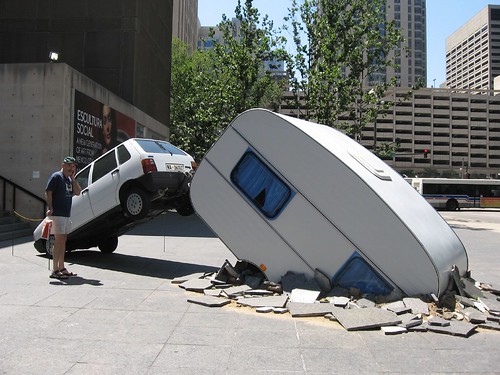
Short Cut, by Michael Elmgreen and Ingmar Dragset
First we were engrossed by the sculptures outside. But what made me really want to go was the Mexican art and the photography exhibit. Of the two, it was the Mexican art that really held my interest. It might not have been a fair fight.

Abraham Cruz-Villegas, Rond point (exhibition copy) acrylic paint, masking tape, aluminum and glass bottles
That’s because I brake for Mexican art. I don’t care whether it’s contemporary or passe; to me it’s an amalgam of indigenous and whatever the powers that be happen to be, and I find those traces of cultures colliding and amalgamating worth some thought. Right now, the powers that be are the U.S. and its political and financial impact. Any visit to an exhibit of Mexican contemporary art raises issues of power and subjugation played out against the Western tradition.
The MCA exhibit, Escultura Social: A New Generation of Art from Mexico City (June 23 – September 2), uses mostly the vocabulary that we know so well–videos, rough installation, indstrial chic sculpture, photography, found objects, etc.–to say something about Mexican political and social realities.
To put it another way, living through any time must always seem like things are in flux, because the outcome is not defined yet. In this particular time, in Mexico, the sense of populations heading for the border must exaggerate that sense, captured in Abraham Cruz-Villegas’ Rond point, with its temporary road signs propped up in glass bottles, waiting for chalk inscriptions to point the way. It had all the tentativeness of a geopolitical reality as yet undefined, awaiting the outcome of a culture war.
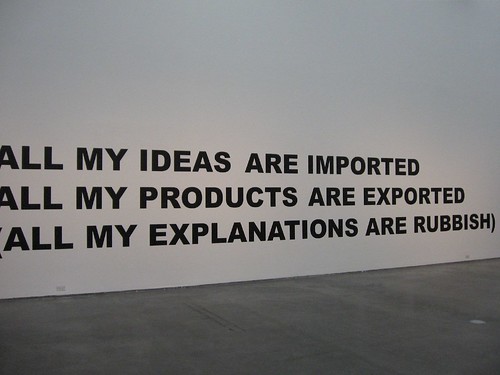
Stefan Bruggemann, Explanations, vinyl
Stefan Bruggemann’s concept piece confronts the reality of the American cultural invasion head-on. And a video by Miguel Calderon, Los pasos del enemigo, is open enough to pass as the same message or any other threat. It’s a blacked-out room with the sounds of a panther and the occasional fleeting appearance of a panther’s glowing teeth or eyes.

Gabriel Kuri, Trinity (voucher), handwoven wool Gobelin (woven in Guadalajara)
I love the wit of the financial values expressed–and questioned–by Gabriel Kuri’s Trinity, a hand-woven trio of tapestries in triplicate–a faithful reproduction of computer-register receipts with their colored copies, all handwoven–in Mexico, of course, where hand labor is still part of the tradition and part of life. Financial issues also come up in Daniel Guzman’s Useless Beauty and Useful Beauty, playing with the value of trinkets and what they represent in a manufacturing culture; financial issues also came up in the credit-card photograph of a mysteriously disappeared hotel in Kabul, by Mario Garcia Torres and Murtaza Roashan, An Expiring ending II. The card has a number to call with a curiously hard-to-pin-down story that matches the curiously hard-to-pin-down image.
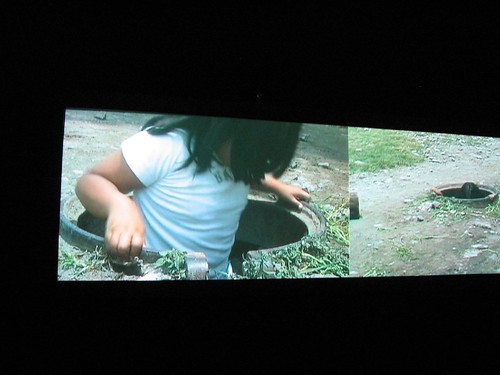
Yoshua Okun, detail, Lago Bolsena, three-channel video
Also playing with the unmappable qualities of reality is Yoshua Okun’s triptych video Lago Bolsena, supposedly of ordinary people’s lives–and not. There’s some play acting going on here as well. And the people coming up out of the manhole suggest the reality of this supposedly nefarious street is not to be seen.
Politics and money are all over this show, but my favorite wag-the-dog piece, for its economy of expression, is by Pedro Reyes. In Leverage, a seesaw balances so far off center that 9 people seated on one end are counterbalanced by one person on the other end. Reyes also plays with the power of perspective in his Klein Bottle Capula, a basket big enough for people to enter, in which inside is out and outside is in. I also liked Gustavo Artigas’ ball game and hoop, recorded in video and photographs, in which the hoop is sideways, Aztec style.
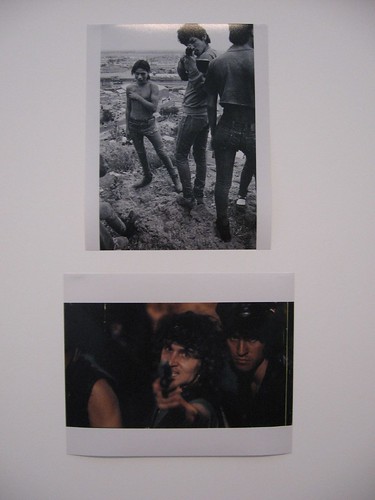
Nuevos Ricos, Los Guererros (The Warriors), documenting Mexican youth culture as portrayed in newspaper photos, juxtaposed with stills from the cult film The Warriors, 1979.
For the most part, this was an exhibit full of conceptual work. Visual juiciness was not its strong suit. But the ideas, from the invasion of gang culture via a movie (Nuevos Ricos’ Los Guererros, above) to the faux artifacts in an installation exploring the pan-American spread of cultural unrest fed my desire for open-ended commentary from south of the border. If you’re in Chicago, check it out.


